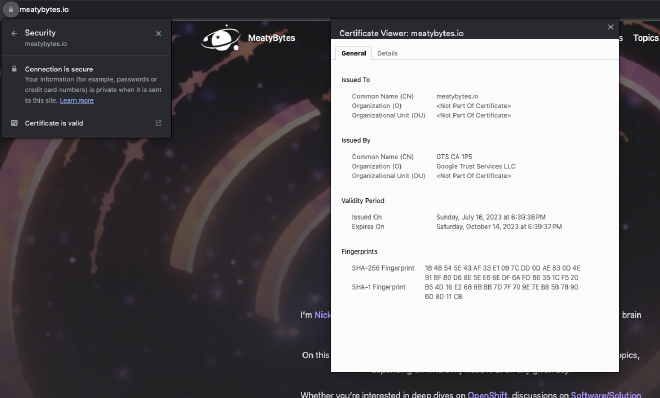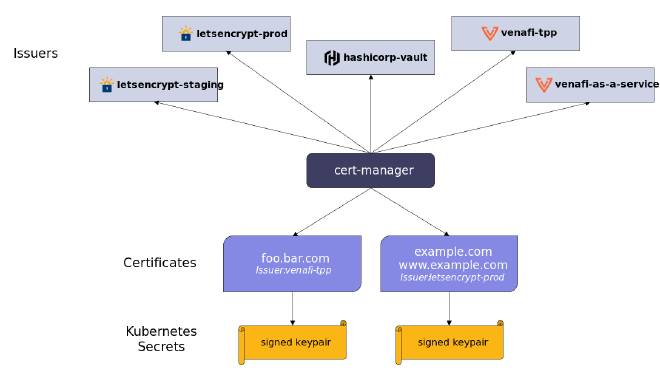Simplify TLS Cert Management with OCP cert-manager Operator
Table of Contents
Introduction #
Welcome to another edition of MeatyBytes.io! Nick Miethe here, your go-to guide in the world of OpenShift, and all things tech.
In today’s cloud-driven landscape, managing TLS certificates and securing communications have become central concerns for any scalable platform. TLS/SSL certificates are a critical component of TLS (Transport Layer Security), a cryptographic protocol used to provide end-to-end security over a network, whether it be public (the internet) or private (LAN).
Each time you access a website using HTTPS (such as this site!), the server responds with its (TLS/SSL) certificate and key to be used for encrypting all communication. The certificate is verified via its root cert, provided by a certificate authority such as Let’s Encrypt. This provides assurance that the owner of the site is the only entity with the private key to decrypt your traffic.

TLS Management #
Managing a single TLS certificate for a website is simple enough, often being managed by your hosting provider. However, managing TLS certificates at scale, such as in Kubernetes/OpenShift, can be a complex and time-consuming task, especially with autoscaling or serverless workloads.
Fortunately, cert-manager provides a powerful solution to simplify TLS certificate management.
Synopsis #
This blog post aims to unravel the role cert-manager in Kubernetes and explain what the OpenShift cert-manager Operator offers over other deployments. Specifically, we’ll explore:
- The Purpose: Why cert-manager is essential and what problems it solves in Kubernetes/OpenShift.
- The Features: What makes the OCP cert-manager Operator unique, the resources it adds, and how to make the right selections.
- The Guide: A comprehensive guide to deploying the operator and implementing TLS certs, complete with tips, tricks, and best practices.
Get ready for a meaty dive into OpenShift’s certificate manager!
Purpose of cert-manager in Kubernetes #
cert-manager is a Kubernetes add-on that automates the management, issuance, and renewal of TLS certificates, and can be used with various Kubernetes resources, such as pods, services, and ingresses.
cert-manager adds several Kubernetes resources (CRDs), including Certificate and Issuer, which supports various certificate authorities (CAs), including Let’s Encrypt. With it, developers can ensure that applications are always serving trusted certificates without manual intervention.
The OpenShift cert-manager Operator Advantage #
The cert-manager Operator, which was recently released to GA, takes the power of cert-manager to the next level by providing an easy-to-use operator that simplifies the deployment and management of TLS certificates. What makes it so powerful? Let’s find out!
Simplified Deployment #
The cert-manager Operator provides a single, easy-to-use deployment manifest that includes all the necessary components for cert-manager. This eliminates the need to create and manage multiple manifests for cert-manager and its dependencies.
The Operator can be deployed via CLI or Web Console, and can be included in your other Day 2 automation deployments along with Observability, GitOps, etc (stay tuned for future posts on OpenShift Day 2 Ops!).
Automated Certificate Management #
The cert-manager Operator automates the process of creating, renewing, and revoking TLS certificates for multiple deployments. The TLS cert assignment to new Ingresses can be fully automated by the cert-manager’s ingress-shim using Annotations on Ingress resources:
apiVersion: networking.k8s.io/v1
kind: Ingress
metadata:
name: ingress-meaty
annotations:
cert-manager.io/cluster-issuer: letsencrypt-issuer
...
This saves time and reduces the risk of errors that can occur when managing certificates manually.
Namespace Isolation #
The cert-manager Operator enables the deployment of a Certificate resource from a given CA cluster-wide via the ClusterIssuer, as well as limited per namespace using Issuer, or a mix of both.
These CRDs provide admins granular control of TLS cert usage and allows isolated certificate management per namespace as needed, while still providing centralized management of other certs.
Customizable Certificate Configurations #
The cert-manager Operator allows for customizing certificate configurations, such as choosing the certificate authority, setting up certificate renewal, and configuring certificate secrets.
The Operator can also be configured for cluster-wide egress proxies as needed, by injecting specific env variables into the Operator subscription. See more on the RH Blog post.
Additional Integration #
The OpenShift cert-manager Operator takes automation to the next level by integrating seamlessly with the Kubernetes API and existing applications. It leverages existing Kubernetes functionality while allowing extensive customization.
For example, the Operator can be integrated with the OpenShift Prometheus Operator via a ServiceMonitor to scrape controller metrics, even monitoring user-defined projects via setting enableUserWorkload: true in the cluster monitoring ConfigMap.
Guide: Deploying OpenShift cert-manager Operator #
Now, let’s roll up our sleeves and explore how to deploy the cert-manager Operator and TLS certs to two different deployments in two different namespaces.
Operator Resources Overview #
The cert-manager Operator consists of several custom Kubernetes resources.
Issuer Types: Resource #
If you need to use a CA across multiple namespaces and aren’t concerned with isolation of the management of the CA issuer, you should use ClusterIssuer which is cluster-wide. Alternatively, you could deploy an Issuer per namespace.
Note: While Issuer’s are localized to a single namespace, and thus are all secrets, ClusterIssuer is cluster-wide. Therefore, it is important to remember which namespace to use when referencing resources, such as with secretName.
The default Cluster Resource Namespace is cert-manager, but it can be changed via the cert-manager-controller as follows:
--cluster-resource-namespace=custom-cluster-namespace
Issuer Types: CA #
There are several types of certificate authorities (CAs) which your cert-manager issuers can represent: SelfSigned, CA, Vault, Venafi, and ACME. You can also choose an External issuer type, using a non-listed issuer.
Generally, people tend to use SelfSigned for testing or lab situations, as it is the simplest to deploy since it doesn’t require a CA cert bundle. The CA type allows for storing your TLS cert and private key bundle as a Kubernetes secret, whereas the Vault type uses CA bundles stored within a HashiCorp Vault.
The most commonly used issuer type in production environments is ACME, providing direct access to CAs such as LetsEncrypt and Cloudflare. When a client requests a Certificate resource via an ACME issuer, they must complete a “Challenge” - HTTP01 or DNS01. DNS challenges can be useful for situations such as wildcard certs, where you want to list the specific DNS names to match to.
Step 1: Install the cert-manager Operator #
First, make sure your OpenShift environment is up and running. Then install the cert-manager Operator via the OperatorHub using 1 of 2 options:
Step 1a: CLI #
oc apply -f https://github.com/jetstack/cert-manager/releases/download/v1.3.1/cert-manager.yaml
Step 1b: Web Console #
Use the OCP Web Console to install the Operator. Make sure it is the correct one!


Install flow of cert-mgr Operator from OperatorHub. Click to view larger: 1, 2, 3
Step 2: Deploy Issuer Resource #
Once the operator is installed, you can configure it with certificate authorities (CAs) to issue and sign your TLS certs. As mentioned above, you have 2 options here: ClusterIssuer and Issuer.
Choose your issuer type from above based on your needs and deploy it. We will be deploying a ClusterIssuer using a SelfSigned type:

If deploying via yaml directly, it should look like this:
apiVersion: cert-manager.io/v1
kind: ClusterIssuer
metadata:
name: selfsigned-issuer
spec:
selfSigned: {}

If you were deploying an issuer type such as CA, you would also need to create a Secret with your CA bundle:
apiVersion: v1
kind: Secret
metadata:
name: ca-key-pair
namespace: cert-manager
data:
tls.crt: {insert-your-tls-crt}
tls.key: {insert-your-tls-key}
Remember to change your namespace if not using ClusterIssuer, or if you’ve changed your default namespace.
Step 3: Deploy TLS Certificates #
There are a couple of routes to deploy a TLS Certificate via the cert-manager Operator. The standard method is via a CertificateRequest resource. This requests a cert from the chosen issuer, creating a Certificate resource in response.
However, the OpenShift Operator provides another, more automated method via Annotations. This allows a deployment to request a Certificate be issued simply by including an annotation in its Ingress resource. This would look as follows in our cluster:
apiVersion: networking.k8s.io/v1
kind: Ingress
metadata:
name: ingress-selfsigned-test
annotations:
cert-manager.io/cluster-issuer: selfsigned-issuer
spec:
...
tls:
- hosts:
- <hostname>
secretName: ingress-secret-selfsigned-test
You can find all supported Annotations in the cert-manager documentation.
Step 4: Validate Certificate #
You can then verify that you TLS cert exists associated with your Ingress resource.
$ oc get cert -o wide
NAME READY SECRET ISSUER STATUS AGE
ingress-secret True ingress-secret-selfsigned-test selfsigned-issuer Certificate is up to date
Conclusion #
The OpenShift cert-manager Operator is more than just a convenient tool; it’s an essential aspect of modern and secure application deployment. Through automation, scalability, and seamless integration, it brings robust certificate management to your fingertips.
By following our step-by-step guide, you have learned how to deploy the operator and TLS certificates across your cluster, ensuring that your applications are always serving trusted certificates. Now go out and use your own certs, whether it be for your workloads or even customizing the web console for your OCP cluster!



